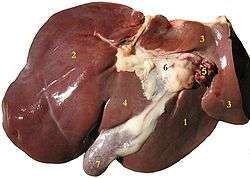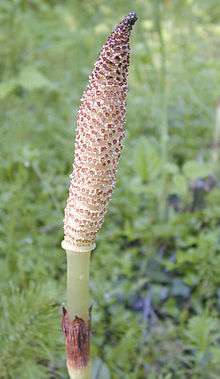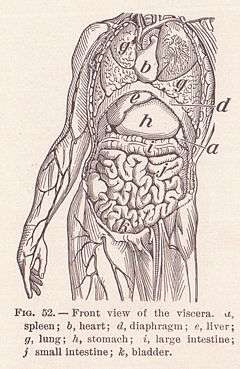Organ (anatomy)
| Organ | |
|---|---|
 The liver of a sheep. The liver is one of the main organs in the body. | |
| Identifiers | |
| FMA | 67498 |
In biology, an organ or viscus is a collection of tissues joined in a structural unit to serve a common function.[1] In anatomy, a viscus (/ˈvɪskəs/) is an internal organ, and viscera (/ˈvɪsərə/) is the plural form.[2][3]
Organs are composed of main tissue, parenchyma, and "sporadic" tissues, stroma. The main tissue is that which is unique for the specific organ, such as the myocardium, the main tissue of the heart, while sporadic tissues include the nerves, blood vessels, and connective tissues. Functionally related organs often cooperate to form whole organ systems. Organs exist in all higher biological organisms, in particular they are not restricted to animals, but can also be identified in plants. In single-cell organisms like bacteria, the functional analogue of an organ is called organelle.
A hollow organ is a visceral organ that forms a hollow tube or pouch, such as the stomach or intestine, or that includes a cavity, like the heart or urinary bladder.
Organ systems
Two or more organs working together in the execution of a specific body function form an organ system, also called a biological system or body system. The functions of organ systems often share significant overlap. For instance, the nervous and endocrine system both operate via a shared organ, the hypothalamus. For this reason, the two systems are combined and studied as the neuroendocrine system. The same is true for the musculoskeletal system because of the relationship between the muscular and skeletal systems.
Mammals such as humans have a variety of organ systems. These specific systems are also widely studied in human anatomy.
- Cardiovascular system: pumping and channeling blood to and from the body and lungs with heart, blood and blood vessels.
- Digestive system: digestion and processing food with salivary glands, esophagus, stomach, liver, gallbladder, pancreas, intestines, colon, rectum and anus.
- Endocrine system: communication within the body using hormones made by endocrine glands such as the hypothalamus, pituitary gland, pineal body or pineal gland, thyroid, parathyroids and adrenals, i.e., adrenal glands.
- Excretory system: kidneys, ureters, bladder and urethra involved in fluid balance, electrolyte balance and excretion of urine.
- Lymphatic system: structures involved in the transfer of lymph between tissues and the blood stream, the lymph and the nodes and vessels that transport it including the Immune system: defending against disease-causing agents with leukocytes, tonsils, adenoids, thymus and spleen.
- Integumentary system: skin, hair and nails.
- Muscular system: movement with muscles.
- Nervous system: collecting, transferring and processing information with brain, spinal cord and nerves.
- Reproductive system: the sex organs, such as ovaries, fallopian tubes, uterus, vagina, mammary glands, testes, vas deferens, seminal vesicles, prostate and penis.
- Respiratory system: the organs used for breathing, the pharynx, larynx, trachea, bronchi, lungs and diaphragm.
- Skeletal system: structural support and protection with bones, cartilage, ligaments and tendons.
Other animals
The organ level of organisation in animals can be first detected in flatworms and the more advanced phyla. The less-advanced taxons (like Placozoa, Porifera and Radiata) do not show consolidation of their tissues into organs.
Plants

The study of plant organs is referred to as plant morphology, rather than anatomy, as in animal systems. Organs of plants can be divided into vegetative and reproductive. Vegetative plant organs are roots, stems, and leaves. The reproductive organs are variable. In flowering plants, they are represented by the flower, seed and fruit. In conifers, the organ that bears the reproductive structures is called a cone. In other divisions (phyla) of plants, the reproductive organs are called strobili, in Lycopodiophyta, or simply gametophores in mosses.
The vegetative organs are essential for maintaining the life of a plant. While there can be 11 organ systems in animals, there are far fewer in plants, where some perform the vital functions, such as photosynthesis, while the reproductive organs are essential in reproduction. However, if there is asexual vegetative reproduction, the vegetative organs are those that create the new generation of plants (see clonal colony).
History

Etymology
The English word "organ" derives from the Latin organum, meaning "instrument", itself from the Greek word ὄργανον, órganon ("implement; musical instrument; organ of the body"). The Greek word is related to ἔργον, érgon ("work").[4] The viscera, when removed from a butchered animal, are known collectively as offal. Internal organs are also informally known as "guts" (which may also refer to the gastrointestinal tract), or more formally, "innards".
Aristotle used the word frequently in his philosophy, both to describe the organs of plants or animals (e.g. the roots of a tree, the heart or liver of an animal), and to describe more abstract "parts" of an interconnected whole (e.g. his philosophical works, taken as a whole, are referred to as the "organon").
The English word "organism" is a neologism coined in the 17th century, probably formed from the verb to organize. At first the word referred to an organization or social system. The meaning of a living animal or plant is first recorded in 1842.[4] Plant organs are made from tissue built up from different types of tissue. When there are three or more organs it is called an organ system.
The adjective visceral, also splanchnic, is used for anything pertaining to the internal organs. Historically, viscera of animals were examined by Roman pagan priests like the haruspices or the augurs in order to divine the future by their shape, dimensions or other factors. This practice remains an important ritual in some remote, tribal societies.
The term "visceral" is contrasted with the term "parietal", meaning "of or relating to the wall of a body part, organ or cavity". The two terms are often used in describing a membrane or piece of connective tissue, referring to the opposing sides.
7 Vital Organs of Antiquity
Some alchemists (e.g. Paracelsus) adopted the Hermetic Qabalah assignment between the 7 vital organs and the 7 Classical planets as follows:[5]
| Planet | Organ |
| Sun | Heart |
| Moon | Brain |
| Mercury | Lungs |
| Venus | Kidneys |
| Mars | Gall bladder |
| Jupiter | Liver |
| Saturn | Spleen |
See also
- List of organs of the human body
- Cloning
- Fascia
- Laboratory-grown organ
- Artificial organ
- Organ transplant
- Organelles, analogous sub-cellular structures
References
- ↑ Widmaier EP; Raff H; Strang KT (2014). Vander's Human Physiology (12th ed.). ISBN 978-0-07-128366-3.
- ↑ "Viscus - Definition". Merriam-Webster Online Dictionary. Retrieved 14 December 2009.
- ↑ "Viscera". MeSH. Retrieved 14 December 2009.
- 1 2 Barnhart's Concise Dictionary of Etymology
- ↑ Philip Ball, The Devil's Doctor: Paracelsus and the World of Renaissance Magic and Science, ISBN 978-0-09-945787-9
{Authority control}